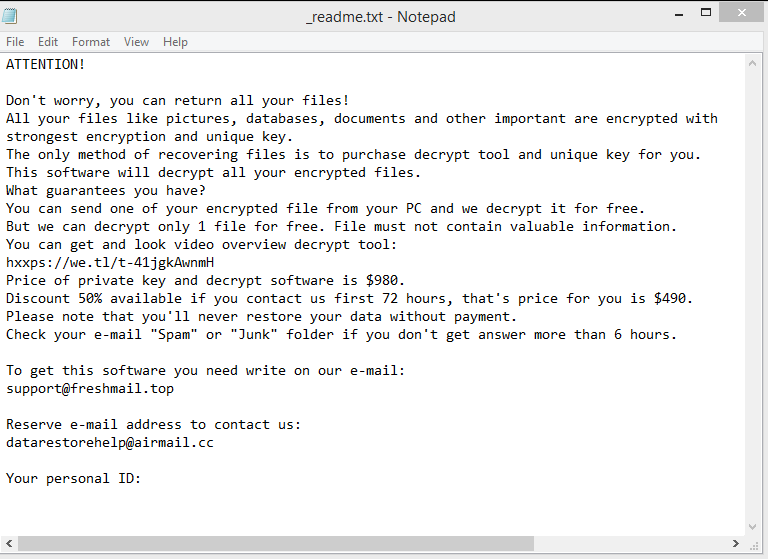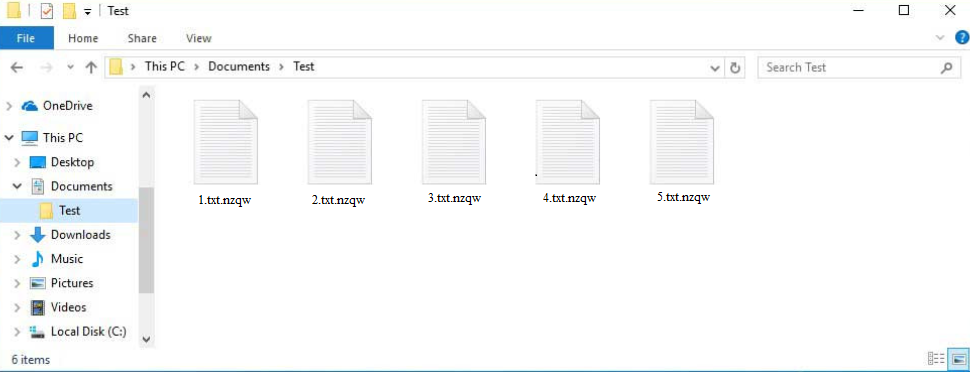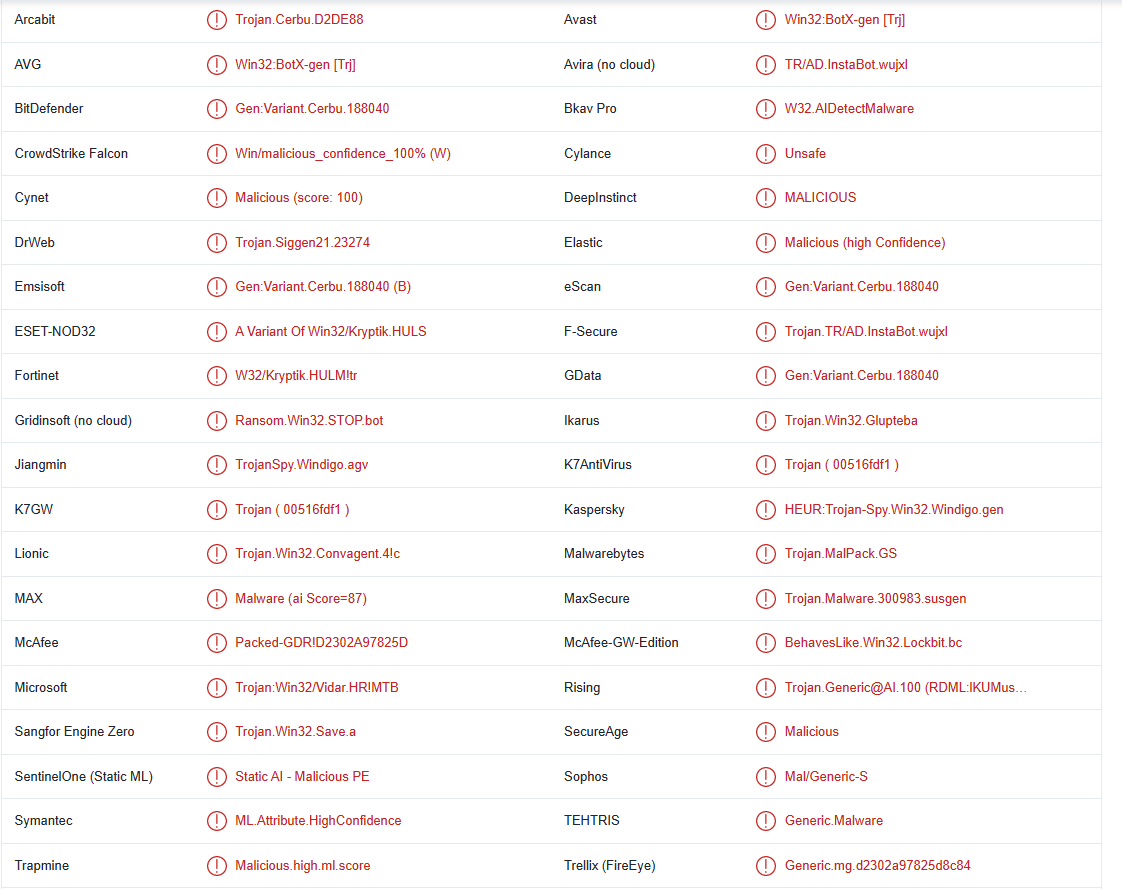Nzqw ransomware is a file-encrypting type of malware from the Djvu/STOP ransomware family. It’s a very dangerous infection because it encrypts personal files. And once they’re encrypted, the files will be unopenable until they’re put through a decryptor. Users with backups will be able to recover files quite easily but those without may lose their files permanently. The malware operators will try to sell you the decryptor but buying it is not recommended.
Nzqw ransomware is initiated as soon as you open the infected file on your computer. It will immediately start encrypting your personal files and show you a fake Windows update window to distract you. Unfortunately, it will encrypt all personal files, including photos, videos, and documents. Affected files will have .nzqw attached to them. For example, text.txt would become text.txt.nzqw.
When files are encrypted fully, the ransomware will drop a _readme.txt ransom note. The note explains that you can buy the decryptor for $980. A 50% discount is also mentioned for users who contact the malware operators within the first 72 hours. Paying the ransom is never recommended because a decryptor won’t necessarily be sent to you. You are dealing with cybercriminals, and they will not necessarily feel obligated to help you.
If you have a backup, you can start recovering your files as soon as you fully delete Nzqw ransomware from your computer. We strongly recommend using a good anti-malware program because it’s a complex infection that requires a professional program.
If you don’t have a backup, waiting for a free Nzqw ransomware decryptor may be the only option. It would be posted on NoMoreRansom if it ever becomes available.
How did Nzqw ransomware infect your computer?
The majority of ransomware infections are distributed using the same methods, torrents, email attachments, malicious downloads, etc. Users who have bad online habits are more likely to pick up malware infections because they tend to open unsolicited email attachments, use torrents to download copyrighted content, and click on random links. Becoming familiar with the distribution methods, as well as developing better habits can go a long way toward preventing infections.
Users are often careless when opening email attachments, and malicious actors take full advantage of that. They purchase leaked email addresses from various hacker forums and launch huge malware-carrying email campaigns targeting them. When users open the malicious files, they initiate the infection, allowing it to carry out its programmed tasks.
Fortunately for users, generic malicious emails are quite easy to recognize. The most obvious sign is grammar and spelling mistakes. Malicious emails are made to appear like they’re sent by legitimate companies but because they’re full of mistakes, it’s immediately obvious. You will rarely see mistakes in legitimate emails because they look unprofessional.
Another sign of a spam or malicious email is you being addressed using generic words like User, Member, Customer, etc. Legitimate emails from companies whose services you use will address you using your name (or rather the name you have given them) to make the email seem more personal. However, in most cases, malware-carrying emails target a large number of users so they’re generic. However, if malicious actors have access to personal information, they can make the emails seem more credible. This is why it’s strongly recommended to scan all email attachments with anti-virus software or VirusTotal before opening them.
Users are discouraged from using torrents to download copyrighted content as well. Not only is that technically content theft, but it’s also an easy way to get ransomware. Torrent sites are quite poorly moderated so malicious actors can upload torrents with malware without issues. Most commonly, malware is found in torrents for movies, TV series, and video games.
Nzqw ransomware removal
Considering that you are dealing with a very serious infection, we strongly recommend using anti-malware software to remove Nzqw ransomware. Manual Nzqw ransomware removal could cause additional problems if you do not know what you’re doing. It’s much safer to use anti-malware software because the program would take care of everything.
After you delete Nzqw ransomware, you can access your backup to start recovering your files. It’s essential that the ransomware is no longer present when you access your backup because otherwise, your backed-up files would become encrypted as well.
If you did not back up your files before your files were encrypted, your only option is to back up your encrypted files and wait for a free Nzqw ransomware decryptor to be released. If it does become available, it will be on NoMoreRansom.
Nzqw ransomware is detected as:
- Win32:BotX-gen [Trj] by AVG/Avast
- A Variant Of Win32/Kryptik.HULS by ESET
- Gen:Variant.Cerbu.188040 by BitDefender
- Packed-GDR!D2302A97825D by McAfee
- Trojan:Win32/Vidar.HR!MTB by Mircosoft
- Ransom.Win32.STOP.YXDH3Z by TrendMicro
- HEUR:Trojan-Spy.Win32.Windigo.gen by Kaspersky
- Trojan.MalPack.GS by Malwarebytes
Offers
Download Removal Toolto scan for Nzqw ransomwareUse our recommended removal tool to scan for Nzqw ransomware. Trial version of provides detection of computer threats like Nzqw ransomware and assists in its removal for FREE. You can delete detected registry entries, files and processes yourself or purchase a full version.
More information about SpyWarrior and Uninstall Instructions. Please review SpyWarrior EULA and Privacy Policy. SpyWarrior scanner is free. If it detects a malware, purchase its full version to remove it.

WiperSoft Review Details WiperSoft (www.wipersoft.com) is a security tool that provides real-time security from potential threats. Nowadays, many users tend to download free software from the Intern ...
Download|more


Is MacKeeper a virus? MacKeeper is not a virus, nor is it a scam. While there are various opinions about the program on the Internet, a lot of the people who so notoriously hate the program have neve ...
Download|more


While the creators of MalwareBytes anti-malware have not been in this business for long time, they make up for it with their enthusiastic approach. Statistic from such websites like CNET shows that th ...
Download|more
Quick Menu
Step 1. Delete Nzqw ransomware using Safe Mode with Networking.
Remove Nzqw ransomware from Windows 7/Windows Vista/Windows XP
- Click on Start and select Shutdown.
- Choose Restart and click OK.

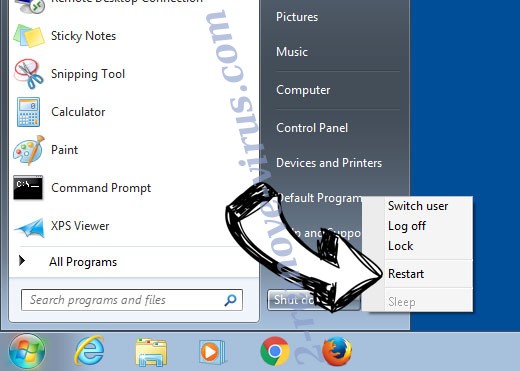
- Start tapping F8 when your PC starts loading.
- Under Advanced Boot Options, choose Safe Mode with Networking.

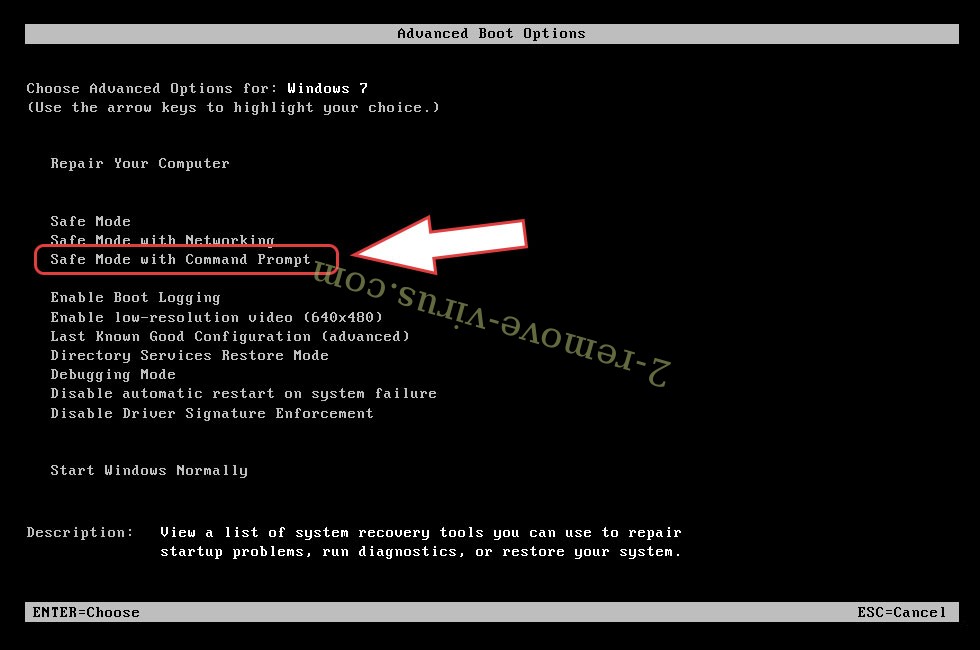
- Open your browser and download the anti-malware utility.
- Use the utility to remove Nzqw ransomware
Remove Nzqw ransomware from Windows 8/Windows 10
- On the Windows login screen, press the Power button.
- Tap and hold Shift and select Restart.

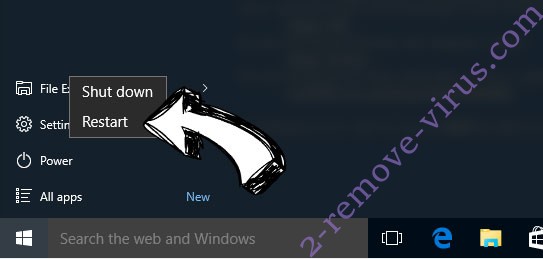
- Go to Troubleshoot → Advanced options → Start Settings.
- Choose Enable Safe Mode or Safe Mode with Networking under Startup Settings.

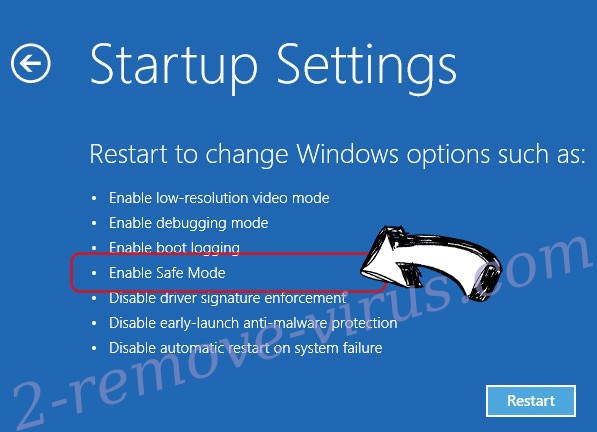
- Click Restart.
- Open your web browser and download the malware remover.
- Use the software to delete Nzqw ransomware
Step 2. Restore Your Files using System Restore
Delete Nzqw ransomware from Windows 7/Windows Vista/Windows XP
- Click Start and choose Shutdown.
- Select Restart and OK


- When your PC starts loading, press F8 repeatedly to open Advanced Boot Options
- Choose Command Prompt from the list.

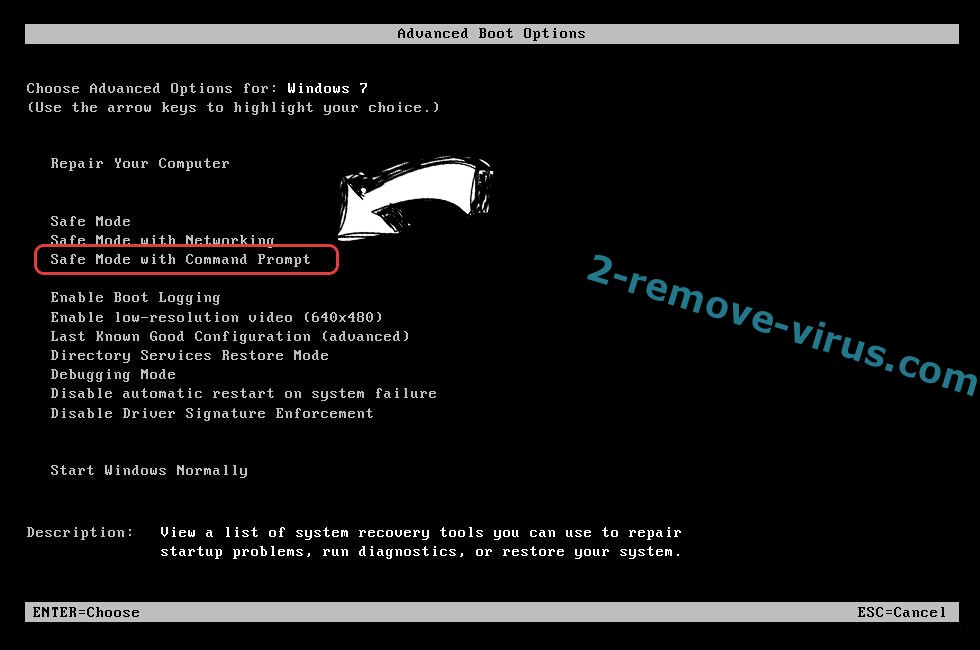
- Type in cd restore and tap Enter.

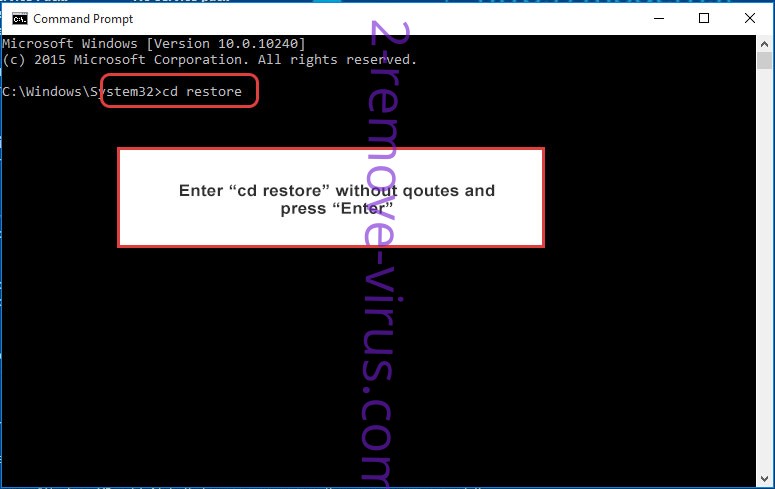
- Type in rstrui.exe and press Enter.

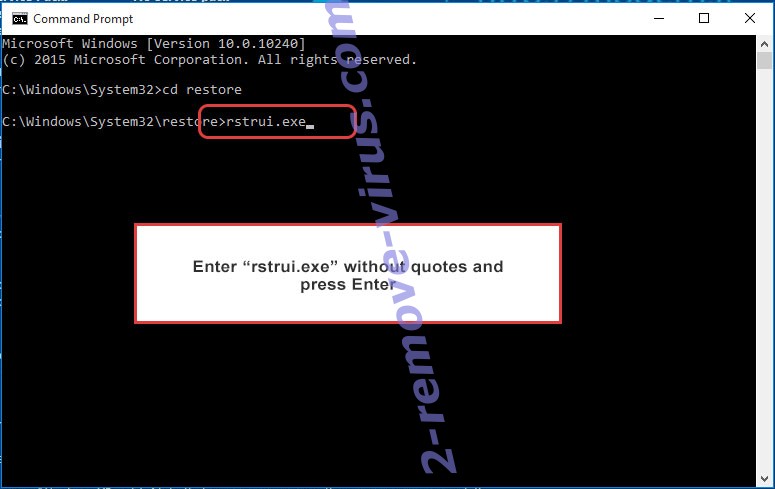
- Click Next in the new window and select the restore point prior to the infection.

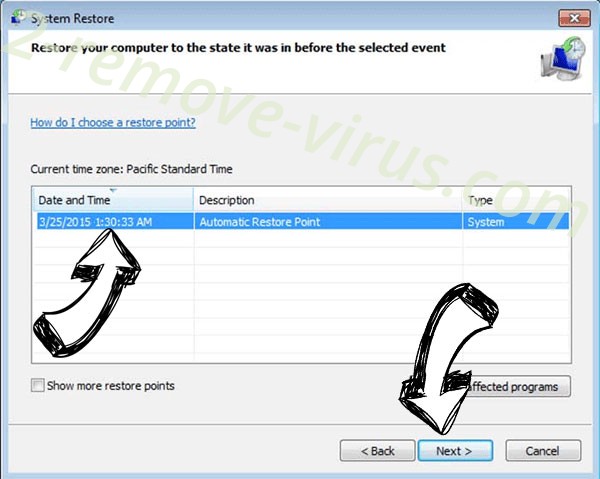
- Click Next again and click Yes to begin the system restore.

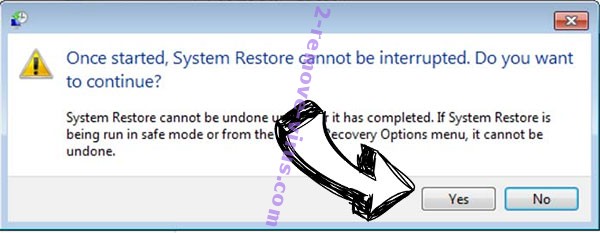
Delete Nzqw ransomware from Windows 8/Windows 10
- Click the Power button on the Windows login screen.
- Press and hold Shift and click Restart.


- Choose Troubleshoot and go to Advanced options.
- Select Command Prompt and click Restart.

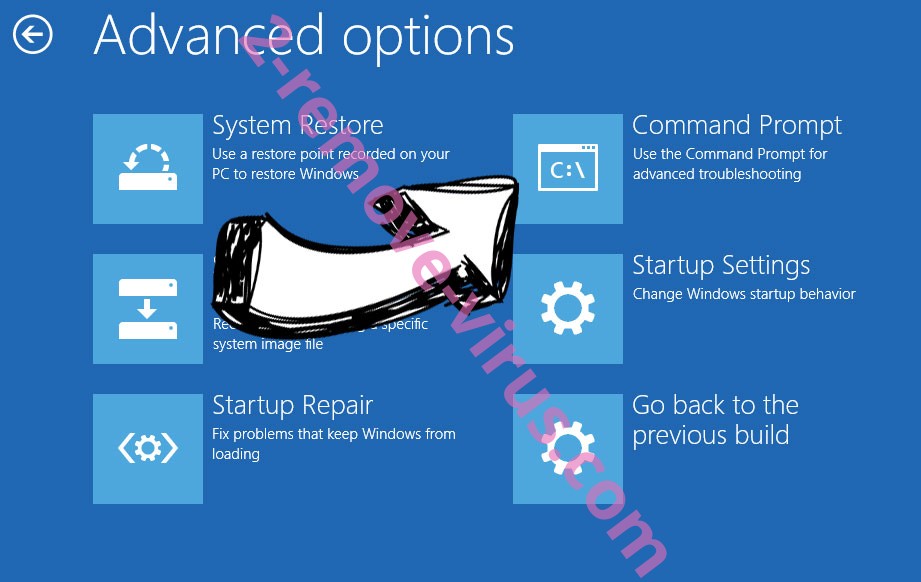
- In Command Prompt, input cd restore and tap Enter.


- Type in rstrui.exe and tap Enter again.


- Click Next in the new System Restore window.

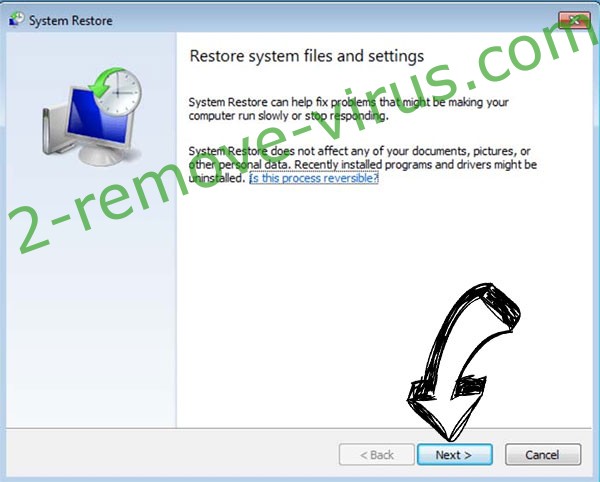
- Choose the restore point prior to the infection.


- Click Next and then click Yes to restore your system.


Site Disclaimer
2-remove-virus.com is not sponsored, owned, affiliated, or linked to malware developers or distributors that are referenced in this article. The article does not promote or endorse any type of malware. We aim at providing useful information that will help computer users to detect and eliminate the unwanted malicious programs from their computers. This can be done manually by following the instructions presented in the article or automatically by implementing the suggested anti-malware tools.
The article is only meant to be used for educational purposes. If you follow the instructions given in the article, you agree to be contracted by the disclaimer. We do not guarantee that the artcile will present you with a solution that removes the malign threats completely. Malware changes constantly, which is why, in some cases, it may be difficult to clean the computer fully by using only the manual removal instructions.
